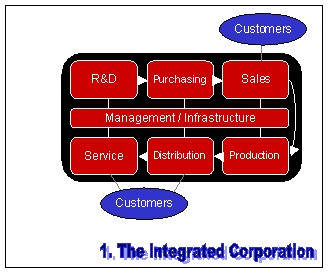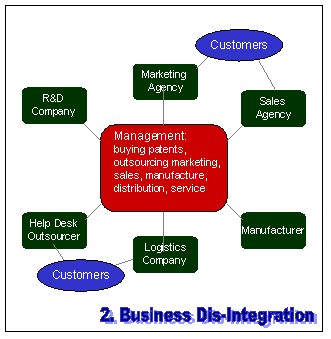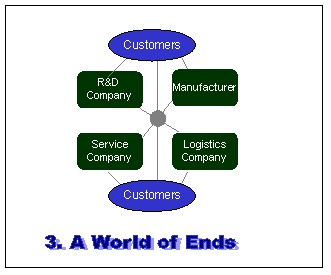 You know business is in trouble when it starts suing its customers. Bad sign. What has led to this terrible state, and what does it mean for the future of business? Let’s take a look at some of the recent trends:
Even manufacturing is often outsourced to plants in third-world countries. Why bother actually owning manufacturing plants when with your purchasing power you have all the benefits of ownership and none of the risks? If the overseas plant uses slave labour, or pollutes the land, “well, we just buy from them, it’s not our responsibility and we have no say in their operations”. And since the employees of these ‘virtual subsidiaries’ aren’t the company’s, they are immune to charges of ‘offshoring’. Even better, if the product reaches the end of its life cycle, you don’t need to deal with layoffs or site disposal — that’s the manufacturing contractor’s problem. You can see the appeal. What is left of the large corporation though? A small management team and an army of lawyers who contract all of the risky functions of the company to outside organizations. Assets that are all intellectual — patents, trademarks, contracts, etc. Essentially no front-line employees, no liabilities, and no risks. And no direct contact with those pesky customers. The corporation has buffered itself against everything. In the all-important ROI, it has minimized its ‘I’, and guaranteed that, while the ‘R’ might not be as high as it was in the high-flying dot-com days, it’s now virtually risk-free. You can’t blame the management of large corporations for doing this. The way corporate, employment, tort and intellectual property law has evolved, and as long as the single overriding objective of corporations is maximizing investor profit, they’re almost pushed into it. The wardens are just running the institution the way they’re told to. But the model in Figure 2 has an achilles heel, and new technology, especially networking technology and the world of ends, gives us a powerful, perhaps even inevitable, means to attack it. In a world of ends, where the network is everything and all the knowledge resides in the network at these ends, there is no longer any need for a middle-man, especially one as costly as the executive in today’s large corporation. The organizations around the outside in Figure 2 merely need to realize this, and start contracting with each other directly. Some smart entrepreneurs are already doing this, connecting these hard-working, risk-taking, mostly small and independent and resilient specialized businesses one-to-one, and providing technology that enables them to deal directly with consumers with no need for the agency of (and the large cut taken by) the large corporation. Lawyers and seven-figure executives need not apply. On the weekend I met with two very bright thinkers on Innovation and Knowledge Management, Jon Husband of Wirearchy and Mike McInerney of Resonance Consulting and Helix Collaboration Commerce. We spent some time talking about Social Networking Software and Personal Productivity Improvement, and ended up talking about how A World of Ends might apply to business. This article is the result, and I thank Jon and Mike for the inspiration. |
Navigation
Collapsniks
Albert Bates (US)
Andrew Nikiforuk (CA)
Brutus (US)
Carolyn Baker (US)*
Catherine Ingram (US)
Chris Hedges (US)
Dahr Jamail (US)
Dean Spillane-Walker (US)*
Derrick Jensen (US)
Dougald & Paul (IE/SE)*
Erik Michaels (US)
Gail Tverberg (US)
Guy McPherson (US)
Honest Sorcerer
Janaia & Robin (US)*
Jem Bendell (UK)
Mari Werner
Michael Dowd (US)*
Nate Hagens (US)
Paul Heft (US)*
Post Carbon Inst. (US)
Resilience (US)
Richard Heinberg (US)
Robert Jensen (US)
Roy Scranton (US)
Sam Mitchell (US)
Tim Morgan (UK)
Tim Watkins (UK)
Umair Haque (UK)
William Rees (CA)
XrayMike (AU)
Radical Non-Duality
Tony Parsons
Jim Newman
Tim Cliss
Andreas Müller
Kenneth Madden
Emerson Lim
Nancy Neithercut
Rosemarijn Roes
Frank McCaughey
Clare Cherikoff
Ere Parek, Izzy Cloke, Zabi AmaniEssential Reading
Archive by Category
My Bio, Contact Info, Signature Posts
About the Author (2023)
My Circles
E-mail me
--- My Best 200 Posts, 2003-22 by category, from newest to oldest ---
Collapse Watch:
Hope — On the Balance of Probabilities
The Caste War for the Dregs
Recuperation, Accommodation, Resilience
How Do We Teach the Critical Skills
Collapse Not Apocalypse
Effective Activism
'Making Sense of the World' Reading List
Notes From the Rising Dark
What is Exponential Decay
Collapse: Slowly Then Suddenly
Slouching Towards Bethlehem
Making Sense of Who We Are
What Would Net-Zero Emissions Look Like?
Post Collapse with Michael Dowd (video)
Why Economic Collapse Will Precede Climate Collapse
Being Adaptable: A Reminder List
A Culture of Fear
What Will It Take?
A Future Without Us
Dean Walker Interview (video)
The Mushroom at the End of the World
What Would It Take To Live Sustainably?
The New Political Map (Poster)
Beyond Belief
Complexity and Collapse
Requiem for a Species
Civilization Disease
What a Desolated Earth Looks Like
If We Had a Better Story...
Giving Up on Environmentalism
The Hard Part is Finding People Who Care
Going Vegan
The Dark & Gathering Sameness of the World
The End of Philosophy
A Short History of Progress
The Boiling Frog
Our Culture / Ourselves:
A CoVid-19 Recap
What It Means to be Human
A Culture Built on Wrong Models
Understanding Conservatives
Our Unique Capacity for Hatred
Not Meant to Govern Each Other
The Humanist Trap
Credulous
Amazing What People Get Used To
My Reluctant Misanthropy
The Dawn of Everything
Species Shame
Why Misinformation Doesn't Work
The Lab-Leak Hypothesis
The Right to Die
CoVid-19: Go for Zero
Pollard's Laws
On Caste
The Process of Self-Organization
The Tragic Spread of Misinformation
A Better Way to Work
The Needs of the Moment
Ask Yourself This
What to Believe Now?
Rogue Primate
Conversation & Silence
The Language of Our Eyes
True Story
May I Ask a Question?
Cultural Acedia: When We Can No Longer Care
Useless Advice
Several Short Sentences About Learning
Why I Don't Want to Hear Your Story
A Harvest of Myths
The Qualities of a Great Story
The Trouble With Stories
A Model of Identity & Community
Not Ready to Do What's Needed
A Culture of Dependence
So What's Next
Ten Things to Do When You're Feeling Hopeless
No Use to the World Broken
Living in Another World
Does Language Restrict What We Can Think?
The Value of Conversation Manifesto Nobody Knows Anything
If I Only Had 37 Days
The Only Life We Know
A Long Way Down
No Noble Savages
Figments of Reality
Too Far Ahead
Learning From Nature
The Rogue Animal
How the World Really Works:
Making Sense of Scents
An Age of Wonder
The Truth About Ukraine
Navigating Complexity
The Supply Chain Problem
The Promise of Dialogue
Too Dumb to Take Care of Ourselves
Extinction Capitalism
Homeless
Republicans Slide Into Fascism
All the Things I Was Wrong About
Several Short Sentences About Sharks
How Change Happens
What's the Best Possible Outcome?
The Perpetual Growth Machine
We Make Zero
How Long We've Been Around (graphic)
If You Wanted to Sabotage the Elections
Collective Intelligence & Complexity
Ten Things I Wish I'd Learned Earlier
The Problem With Systems
Against Hope (Video)
The Admission of Necessary Ignorance
Several Short Sentences About Jellyfish
Loren Eiseley, in Verse
A Synopsis of 'Finding the Sweet Spot'
Learning from Indigenous Cultures
The Gift Economy
The Job of the Media
The Wal-Mart Dilemma
The Illusion of the Separate Self, and Free Will:
No Free Will, No Freedom
The Other Side of 'No Me'
This Body Takes Me For a Walk
The Only One Who Really Knew Me
No Free Will — Fightin' Words
The Paradox of the Self
A Radical Non-Duality FAQ
What We Think We Know
Bark Bark Bark Bark Bark Bark Bark
Healing From Ourselves
The Entanglement Hypothesis
Nothing Needs to Happen
Nothing to Say About This
What I Wanted to Believe
A Continuous Reassemblage of Meaning
No Choice But to Misbehave
What's Apparently Happening
A Different Kind of Animal
Happy Now?
This Creature
Did Early Humans Have Selves?
Nothing On Offer Here
Even Simpler and More Hopeless Than That
Glimpses
How Our Bodies Sense the World
Fragments
What Happens in Vagus
We Have No Choice
Never Comfortable in the Skin of Self
Letting Go of the Story of Me
All There Is, Is This
A Theory of No Mind
Creative Works:
Mindful Wanderings (Reflections) (Archive)
A Prayer to No One
Frogs' Hollow (Short Story)
We Do What We Do (Poem)
Negative Assertions (Poem)
Reminder (Short Story)
A Canadian Sorry (Satire)
Under No Illusions (Short Story)
The Ever-Stranger (Poem)
The Fortune Teller (Short Story)
Non-Duality Dude (Play)
Your Self: An Owner's Manual (Satire)
All the Things I Thought I Knew (Short Story)
On the Shoulders of Giants (Short Story)
Improv (Poem)
Calling the Cage Freedom (Short Story)
Rune (Poem)
Only This (Poem)
The Other Extinction (Short Story)
Invisible (Poem)
Disruption (Short Story)
A Thought-Less Experiment (Poem)
Speaking Grosbeak (Short Story)
The Only Way There (Short Story)
The Wild Man (Short Story)
Flywheel (Short Story)
The Opposite of Presence (Satire)
How to Make Love Last (Poem)
The Horses' Bodies (Poem)
Enough (Lament)
Distracted (Short Story)
Worse, Still (Poem)
Conjurer (Satire)
A Conversation (Short Story)
Farewell to Albion (Poem)
My Other Sites







I follow and endorse this plan all the way with one small exception: You don’t explain the grey dot in the middle of the last diagram, the co-ordinating hub. This was the stumbling block we encountered in our collaboration with Industry Canada to do what you describe for a network of edu-tainment companies. Each subtask was well defined and covered, but we lacked the co-ordination/alert infrastructure (and member skills) to effect a fast response when faced with a call from the logistics or service company.Where it does appear to work, and work very well, is when the grey dot is trust, and each box is mapped to just one company. This means a business web that is a fixed association of independent businesses who use each other as their vendor of preference for that service. If LC gets a call, there is only one R&D to call (in that category of product), and similarly a small set of manufacturing and service options. Our Industry Canada plan tried to go too big, wanting to link companies with overlapping services, dozens of them, and what happened instead was the Logistics was unable to respond in time. The other error we made was in trying to borrow Logistics from each member instead, as you put here, set them up as an independent entity with a core need to be the logistics — I called these people “outsource middle management” although I also distinguished between the project co-ordinators, planners, architects as one group, and the pre-sales, prospectors as another group (they seem very different entities to me).
Interesting Dabe – as you may know I come recently from a telecom background and I’ve written extensively (though not of late) about this stuff. If you aren’t familiar with David Isen and his paper “The Rise of the Stupid Network” I highly recommend it. It is probably available off his website http://www.isen.com. If you don’t know it, stupid, in tha above title, refers to the need for the intelligence of networks to occur at the network edge. This is what TCP/IP does it obviates the need for intelligent telecom networks like ATM and Frame Relay where all the control (intelligence) of the network resides in the telco’s control.
Very well written, and so true.You are definitely the thinking mans’ blog. I must come here more often.Stu
As I note in my responsive blog post (see trackback for URL), Dave’s thoughts are insightful as regards advances in what you could call organizational technology. And he’s right on with his critique of (some) contemporary management’s adversarial relationship with its own customers. But I question his notion that the corporation isolated by outsourcing takes no risks — it is often still the entity that assembles and distributes much or most of the capital employed in the overall enterprise, and ultimately bears significant risk in hopes of reaping significant return on investment. It is a separate question whether management itself has managed to shrug off too much risk due to defects in executive job markets, etc. And there’s always the perennial problem of bankruptcy as a means for escaping losses, but that’s as much a problem with the contractors (assuming they operate in a legal system that has bankruptcy) as for the management/litigation corporation.
Gary: The grey box could be ‘trust’; it could also be Social Networking Applications.Subdude: I get your point. It seems to me that as long as there a customers, there will be some risks. But outsourcing does buffer the risks. If the product suddenly stop selling, you stick the outsourced manufacturer with the unsold inventory. It’s a lot like the ‘consignment’ model used in printed matter in retailing, and even more like the Wal-Mart model, where Wal-Mart essentially takes ownership of nothing — they just lease shelf space and all the risk of unsold product is with the manufacturer.